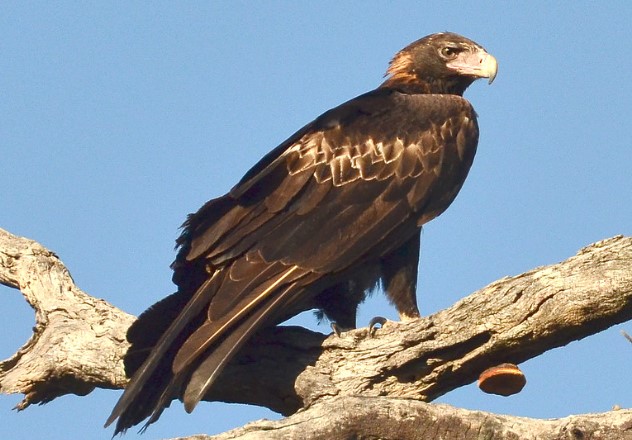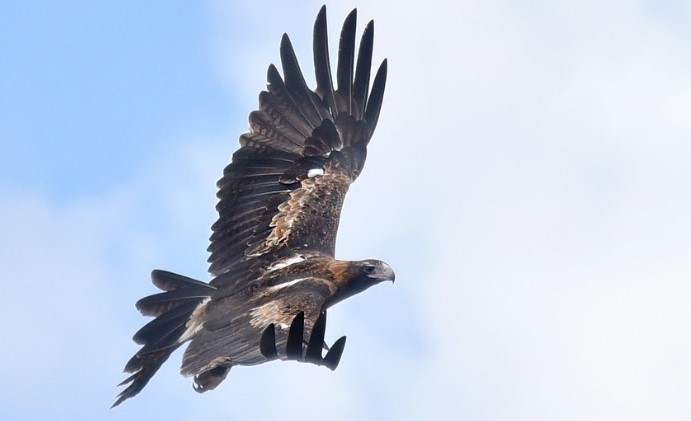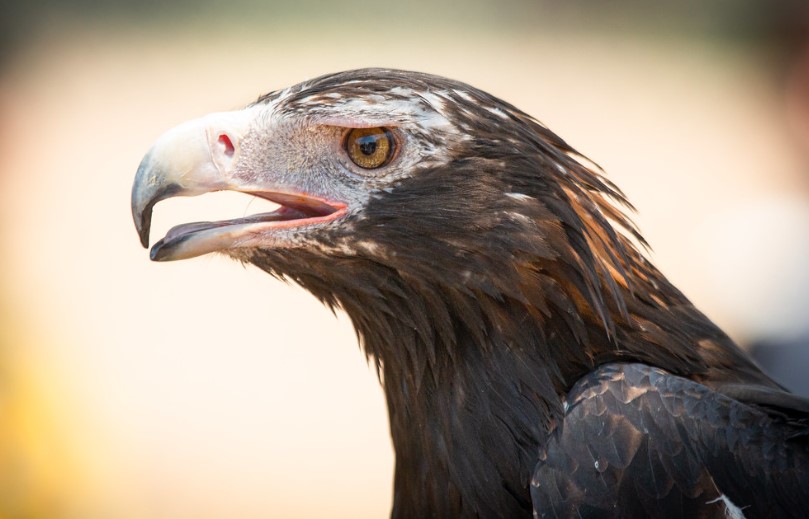FAMILY: The Wedge-tailed eagle (Aquila audax) is not only the largest bird of prey in Australia, but it is also found in southern New Guinea to the north, and its distribution extends as far south as the state of Tasmania. In 1801, the English ornithologist John Latham gave the wedge-tailed eagle its first scientific name, Vultur audax.
SIZE: With a wingspan of up to 2.5 meters, the Wedge-tailed Eagle is the largest bird of prey in Australia. The size of a Male bird is about 900 mm, and the female is 1000 mm.
DIET: Wedge-tailed eagle is a lanky bird, it hunts by soaring high, circling up on thermal air currents for hundreds of meters, and sailing out over the countryside, covering wide areas on upswept wings, its tail fanned and diamond-shaped. Sighting prey, it sweeps down onto it in a long, slanting swoop, but it is more often unsuccessful than not when chasing live prey: rabbits, wallabies, small kangaroos, and, where these are scarce, various ground-dwelling and swamp birds and reptiles. Some of its primary food sources include rabbits, hares, wallabies, kangaroos, and possums. It also feeds on feral animals such as pigs and goats and scavenges on roadkill and other carrion.
HABITATS: Wedge-tailed eagle is widely distributed throughout Australia, they can be found in diverse habitats, from deserts, semi-deserts, plains, and mountains to forests, and occasionally, even tropical rainforests. Although they show a preference for habitats with varied topography, including rocky terrain, open spaces, and stands of native Eucalyptus woodlots.
Nearly all prey is taken on open ground, and the eagles usually feed there. Much carrion is taken too, and the eagles sometimes congregate vulture-like in groups of 20 or 30 at kills. Only rarely do more than two eagles feed on a carcass at a time, the others standing or perching nearby, digesting or waiting their turn. When earlier this century eagles were found on dead sheep or lambs, it was thought that they had killed them. Bounties were paid for their destruction.

BEHAVIOUR: Bounties amounting to 10,000 were paid in a single year in Queensland, and between 1927 and 1968, another 150,000 were paid in Western Australia before it was recognized that the eagles primarily preyed on weak, dying, or deceased lambs and had minimal impact on the sheep industry, leading to the discontinuation of the practice. Today they are protected in all states. Most eagles congregating at kills are nomadic young birds. Adults mate permanently and hold to the same home range throughout the year, breeding there. They usually spend the hours around sunrise and sunset quartering part of their territory at treetop level.
For the rest of the day, they either sit about on exposed perches or circle and glide, soaring for as much as 90 minutes at a time. Little time is spent maintaining territory, but the eagles advertise occupancy by high aerial flights and may glide along presumed boundaries. Acrobatic display flights herald breeding. The male dives down at speed as the female pulls out and rises on part-opened wings. She ignores him or turns on her back to present claws, and they may loop the loop, calling much.
Often in mid-morning and mid-afternoon, they perch together and preen one another. They usually have several nests in their territory, one of which is used each season. Both sexes repair it, bringing in sticks in bill or feet, and the male lining it daily with fresh leaves when the female is incubating and breeding. He also relieves her on the nest occasionally and does all the hunting until the chicks are too old to brood, bringing food to a perch near the nest and passing it to the female there. Prey, commonly rabbits, is roughly skinned and shredded by the female, and she passes morsels to the young, dripping with saliva at early stages.
Brooding ceases at about 30 days when the pins of mature plumage begin to show through the chicks’ down. Then both parents leave to hunt and bring food and leaves to freshen the nest. In a good season, two chicks may be reared, but mostly only one survives by killing its sibling. In arid, drought-affected regions, the birds may not breed at all for several years at a time.
Despite being heavily persecuted by humans in the past through poisoning and shooting, primarily due to their alleged predation on sheep, wedge-tailed eagles have demonstrated remarkable resilience, quickly rebounding to similar or even higher numbers than pre-colonization levels. This is partially due to humans unintentionally providing them with several food sources, such as rabbits and a large number of roadkills.

ALTERNATIVE NAMES: It is also known as Eagle-hawk.
IDENTIFICATION: Both sexes have similar black plumage. The nape, wing coverts, and undertail coverts are dark russet-brown. The tail is long and wedge-shaped. The eye color is hazel-brown. The bill is dull white with a dark tip, and the cere is very pale yellow. The claws are black.
IMMATURES: The upper parts are brown, and the nape ranges in color from yellow to golden brown. The underparts are dark brown with pale edges to the feathers. They become gradually darker with age but don’t turn black until they are five to six years old.
DOWNY YOUNG: They are white, with grey eyes. The cere and toes are pale yellow, and the bill is dusky.
VOICE: The wedge-tailed eagle has a variety of vocalizations. The most commonly heard call is a repeated double whistle, described as “pee-yaa”. They also make a loud, cat-like screech, especially when disturbed from their nest, and a slurred “yessir” when showing aggression. During mating season, they produce loud screeches with double notes and rising inflection. They can also be silent at times.
NESTING: They lay most eggs from June to August in southern Australia, and from April in the north. Their nest is a very large platform of sticks, 1-2.5 meters in diameter, lined with green leaves. Fresh leaves are added regularly during breeding. The nest is re-used and added to year after year. It is usually placed on a fork of a tree, 1-30 meters above the ground, and sometimes on cliffs. Wedge-tailed eagles typically reach sexual maturity at around four to five years of age.
EGGS: They lay one to three eggs, usually two, which are white to pale buff-grey and sparsely splotched with purple and brown. One egg is invariably more lightly marked than the other and occasionally pure white. The eggs are rounded-oval and about 73 x 58 mm. The female incubates the eggs for about 45 days, and the young fledge in 70-90 days.
SUBSPECIES: There are two recognized subspecies of the Wedge-tailed eagle:
-
A. a. audax, found on mainland Australia and
-
A. a. fleayi, found in Tasmania.
The Tasmanian subspecies is generally larger and has a distinct yellow coloration on its nape, which is lacking in the mainland subspecies.
DISTRIBUTION: Wedge-tailed Eagle is fairly common over forests and open country on plains and mountains throughout mainland Australia and Tasmania. They are also found in southern New Guinea. There are two races: one on the mainland and the other naped and large-taloned in Tasmania.
Their range extends from the Cape York Peninsula in the north down to Wilsons Promontory National Park and Great Otway National Parks in the southern tips of the continent and from Shark Bay in the western side of the continent to Great Sandy National Park and Byron Bay in the east. They are widespread throughout the desert interior of Australia, although they are rare in the aridest parts of the continent. They are also distributed in several of the larger and smaller Australian islands, as well as in some parts of New Guinea. Read More – Unalaska – The Town of Violent Bald Eagles







